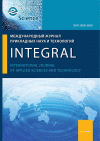A decoding technique was applied using geoinformation systems and technologies based on remote sensing data in a study of forest vegetation with the aim of developing a more efficient method for deciphering forest inventory and obtaining maps of forestation of reference forest areas. The signs of interpretation for the analysis of the initial data, the distribution of objects into groups, the study of the features of forest taxation interpretation, the classification of groups by forest taxation features, the fixation of studies in the software environment and the subsequent display of the results are used. With the help of interpretation skills, data analysis was performed, which resulted in the basic classification of objects into groups according to more general characteristics, and then the thematic classification of the selected groups of forest communities. Since the subject of the study is the application of geoinformation systems and technologies in the field of forest-affected decoding, the fulfillment of all tasks was fixed in the software environment. The authors determine that one of the main stages of forest-affected decoding is the determination of the wood composition of forests. In order to determine the wood composition, it is necessary to identify certain characteristics and differences of each tree species from each other. In the pictures we see only the crowns of trees, so all the signs of recognition are determined by them. The key goal of forest-space decoding of space is established - the recognition of what species make up certain forest areas, as well as the determination of quantitative taxation indicators. At present, it is possible to obtain all the necessary remote sensing data of the Earth in high resolution, which will help to study the forest almost to the detailed level.
Forest taxation research, geoinformation technologies, space images, recognition of tree species
1. Permitina L.I. Operativnyy sputnikovyy monitoring sostoyaniya okruzhayuschey sredy i zemlepol'zovaniya // ARCREVIEW. 2005. №3(34). S. 18-24.
2. Krylov A.M., Sobolev A. A., Vladimirova N. A. Vyyavlenie ochagov koroeda-tipografa v Moskovskoy oblasti s ispol'zovaniem snimkov Landsat // Vestnik Moskovskogo gosudarstvennogo universiteta lesa Lesnoy vestnik. 2011. №4. S. 54-60.
3. Nazarov V.G., Habarov D.A., Azarov D.A. Ispol'zovanie materialov kosmicheskoy s'emki pri ocenke prirodno-resursnogo potenciala urbanizirovannyh territoriy // Moskovskiy ekonomicheskiy zhurnal. 2017. №2. 4 S.
4. Habarova I.A., Gilyuk A.V., Druchinin S.S. Geologo-geograficheskoe izuchenie lesoparkovyh territoriy s ispol'zovaniem kosmicheskih izobrazheniy // Moskovskiy ekonomicheskiy zhurnal. 2017. №2. 13S.
5. Habarova I.A., Vorob'eva S.N., Druchinin S.S. Ispol'zovanie materialov distancionnogo zondirovaniya dlya celey monitoringa zemel' // Moskovskiy ekonomicheskiy zhurnal. №2. 2 S.
6. Jacobson R.A., Lainey V. Martian satellite orbits and ephemerides // Planetary and space science. V.102. No. C. Pp. 35-44.
7. Uchaev Dm.V., Uchaev D.V., Prutov I.S. Mnogomasshtabnoe predstavlenie gravitacionnyh poley malyh nebesnyh tel// Izvestiya vysshih uchebnyh zavedeniy. Geodeziya i aerofotos'emka. 2013. №4. C. 3-8.
8. Uchaev D.V., Malinnikov V.A. Chebyshev-based technique for automated restoration of digital copies of faded photographic prints // Journal of electronic imaging. V.26. No.1. Pp. 011024.
9. Voronin A.V. Algoritm tehnicheskogo zreniya dlya bespilotnogo letatel'nogo apparata sel'skohozyaystvennogo naznacheniya // Politehnicheskiy molodezhnyy zhurnal. 2017. №8(13). S. 1.
10. Chaban L.N., Malinnikov V.A., Uchaev D.V., Uchaev Dm. V. Metody otbora informativnyh kanalov pri tematicheskoy obrabotke giperspektral'nyh izobrazheniy // Izvestiya vysshih uchebnyh zavedeniy. Geodeziya i aerofotos'emka. 2014. №4. C. 63-74.
11. 1. Permitina L.I. Operational satellite monitoring of the state of the environment and land use // ARCREVIEW. 2005. 3(34). Pp. 18-24.
12. 2. Krylov A.M., Sobolev A. A., Vladimirova N. A. Identification of foci of bark beetle in Moscow region using Landsat images// Vestnik Moskovskogo gosudarstvennogo universiteta lesa Lesnoj vestnik = Bulletin of the Moscow State Forest University. 2011. No.4. Pp. 54-60.
13. 3. Nazarov V.G., Khabarov D.A., Azarov D.A. Use of space imagery materials in assessing the natural resource potential of urbanized territories // Moskovskij ehkonomicheskij zhurnal = Moscow Economic Journal. 2017. No.2. 4 Pp.
14. 4. Khabarova I.A., Gilyuk A.V., Druchinin S.S. Geological and geographical study of forest park territories using space images // Moskovskij ehkonomicheskij zhurnal = Moscow Economic Journal. 2017. No. 2. 13Pp.
15. 5. Khabarova I.A., Vorob’eva S.N., Druchinin S.S. Use of remote sensing materials for land monitoring purposes // Moskovskij ehkonomicheskij zhurnal = Moscow Economic Journal. 2017. No. 2. 2 Pp.
16. 6. Jacobson R.A., Lainey V. Martian satellite orbits and ephemerides // Planetary and space science. 2014. V.102. No. C. Pp. 35-44.
17. 7. Uchaev Dm.V., Uchaev D.V., Prutov I.S. Multi-scale representation of gravitational fields of small celestial bodies // Izvestiya vysshih uchebnyh zavedenij. Geodeziya i aehrofotos»emka = Izvestia vuzov. Geodesy and aerophotography. 2013. No. 4. Pp. 3-8.
18. 8. Uchaev D.V., Malinnikov V.A. Chebyshev-based technique for automated restoration of digital copies of faded photographic prints // Journal of electronic imaging. 2017. V.26. No.1. Pp. 011024.
19. 9. Voronin A.V. The algorithm of technical vision for an unmanned aerial vehicle for agricultural purposes // Politekhnicheskij molodezhnyj zhurnal = Politechnical student journal. 2017. No. 8(13). Pp. 1.
20. 10. Chaban L.N., Malinnikov V.A., Uchaev D.V., Uchaev Dm. V. Methods of selecting informative channels for thematic processing of hyperspectral images // Izvestiya vysshih uchebnyh zavedenij. Geodeziya i aehrofotos»emka = Izvestia vuzov. Geodesy and aerophotography. 2014. No.4. Pp. 63-74.













